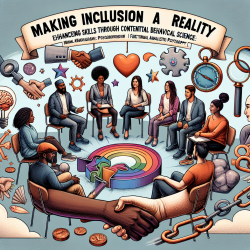Introduction
In recent years, the focus on social inclusion and equality for transgender individuals has become a pivotal aspect of developmental research. The paper "Transgender Social Inclusion and Equality: A Pivotal Path to Development" provides a comprehensive analysis of the barriers faced by transgender people and offers actionable solutions to promote their inclusion. As practitioners in speech-language pathology, it is imperative to integrate these insights into our practice to foster inclusive environments for all children, including those who identify as transgender.
Understanding the Challenges
The research highlights that transgender individuals often face extreme social exclusion, which translates into increased vulnerability to health issues, limited access to education and employment, and a loss of opportunities for economic and social advancement. For speech-language pathologists, understanding these challenges is crucial. Children who identify as transgender may experience unique communication barriers due to societal stigma and discrimination, impacting their ability to express themselves effectively.
Actionable Strategies for Practitioners
To improve outcomes for transgender children, practitioners can implement the following strategies:
- Create a Safe and Inclusive Environment: Establish a welcoming atmosphere where all children feel safe to express their gender identity. Use inclusive language and respect preferred pronouns to affirm their identity.
- Educate and Advocate: Educate yourself and others about transgender issues and advocate for inclusive policies within your practice and community. This includes training staff on gender sensitivity and creating resources that reflect diverse identities.
- Individualized Assessment and Intervention: Tailor assessments and interventions to meet the unique needs of transgender children. Consider their social context and potential barriers to communication when developing therapy plans.
- Collaborate with Families and Schools: Work closely with families and educational institutions to support transgender children. Provide guidance on creating supportive environments at home and in school settings.
Encouraging Further Research
While the current research provides valuable insights, ongoing investigation is essential to continue improving outcomes for transgender individuals. Speech-language pathologists are encouraged to engage in research initiatives that explore the intersection of gender identity and communication development. By contributing to the body of knowledge, practitioners can help shape policies and practices that promote equality and inclusion.
Conclusion
Integrating the outcomes of the research on transgender social inclusion and equality into speech-language pathology practice is not only a professional responsibility but also a moral imperative. By fostering inclusive environments and advocating for the rights of transgender individuals, practitioners can contribute to a more equitable society where all children have the opportunity to thrive.
To read the original research paper, please follow this link: Transgender social inclusion and equality: a pivotal path to development.










